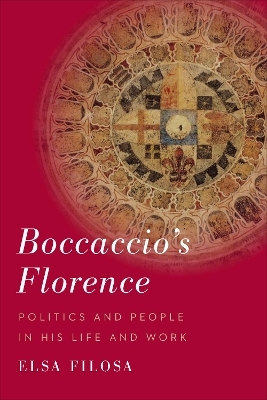
Boccaccio's Florence
University of Toronto Press (Verlag)
978-1-4875-0580-6 (ISBN)
Best known as the author of the Decameron, Giovanni Boccaccio is a key figure in Italian literature. In the mid-fourteenth century, however, Boccaccio was also deeply involved in the politics of Florence and the extent of his involvement steered and inspired his work as a writer.
Boccaccio’s Florence explores the financial, political, and social turbulence of Florence at this time, as well as the major players in literary and political circles, to understand the complex ways they emerged in Boccaccio’s writing. Based on extensive archival research and close reading of Boccaccio’s works, the book aims to recover the dynamics of the Florentine conspiracy of 1360 and how this event affected Boccaccio’s writing, arguing that his works reveal clear references to this episode when read in light of the reconstructed historical context.
In this rich and textured picture of the man in his time, Elsa Filosa documents a microhistory of connections and interconnections and offers new, more political and historically imbedded readings of Boccaccio’s seminal works.
Elsa Filosa is an assistant professor of the practice in Italian at Vanderbilt University.
List of Illustrations and Tables
Acknowledgments
Introduction
Part One: Power and Politics in Boccaccio’s Times
1. An Apprenticeship in Politics, 1341–43
From Naples to Florence: Santa Felicita in Oltrarno
The Bardi Conspiracy of 1340
“Endeavour to make one or more friends”
The Call and the Fall of the Duke of Athens
2. Boccaccio and Politics, 1348–55
The Plague and Its Aftermath
Boccaccio’s Political Years, 1348–55
“Petrarch’s War” and the War against the Visconti
Boccaccio’s Last Offices and Disappearance
3. The 1360 Conspiracy, 1359–61
The Guelf Party and Terror of the Ammonizioni
The Ringleaders
The Dynamics of the Conspiracy
The Informants
The Death Sentence
The Other Conspirators
4. Consequences, 1361–65
Defamatory Portraits
The Executed: Niccolò di Bartolo del Buono and Domenico Bandini
The Exiles: The Case of Luca di Feo Ugolini
Boccaccio’s Withdrawal to Certaldo
Part Two: At the Intersections of Literature and Politics
5. Anti-tyrannical Motives in De mulieribus claris
Friendship in Time of Conspiracy
Florence: The Prostitutes Venus and Flora and the Seduced Hercules
Anti-tyrannical Motives
The Stoic Suicide: Escape toward Freedom
6. The Consolatoria a Pino de’ Rossi: A Manifesto on Innocence
Who Was Pino de’ Rossi?
Boccaccio's Letter: A Manifesto on Innocence
Against Judges: Milex Ludovicus Juvinalis Cardolis de Narnia
The Corruption of the Florentines
Pino de’ Rossi and Friends
The Consolations of Giovanni Boccaccio
The Questionable Innocence of Pino de’ Rossi
Summary of Boccaccio’s Consolatoria a Pino de’ Rossi
7. The Lives of Dante
The Life of Dante: First Version
Self-Censorship in the Second Version
The Deletion of Monarchia
A Change of Audience
Lapo da Castiglionchio
Tensions with Petrarch: On the Solitary Life
Boccaccio’s Enduring Fidelity to Dante
8. Conspirators in the Decameron
What’s in a Name: Donati and Monna Nonna
Decameron VI: The Florentine Day
Fortune and Nature: A Philosophical Debate
Noble Blood versus Noble Soul: A Political Debate
Founding the Utopian City
Afterword
| Erscheinungsdatum | 29.09.2022 |
|---|---|
| Reihe/Serie | Toronto Italian Studies |
| Zusatzinfo | 11 b&w illustrations |
| Verlagsort | Toronto |
| Sprache | englisch |
| Maße | 159 x 235 mm |
| Gewicht | 660 g |
| Themenwelt | Geisteswissenschaften ► Archäologie |
| Geschichte ► Allgemeine Geschichte ► Neuzeit (bis 1918) | |
| Geisteswissenschaften ► Sprach- / Literaturwissenschaft ► Anglistik / Amerikanistik | |
| Geisteswissenschaften ► Sprach- / Literaturwissenschaft ► Literaturwissenschaft | |
| ISBN-10 | 1-4875-0580-9 / 1487505809 |
| ISBN-13 | 978-1-4875-0580-6 / 9781487505806 |
| Zustand | Neuware |
| Haben Sie eine Frage zum Produkt? |
aus dem Bereich


